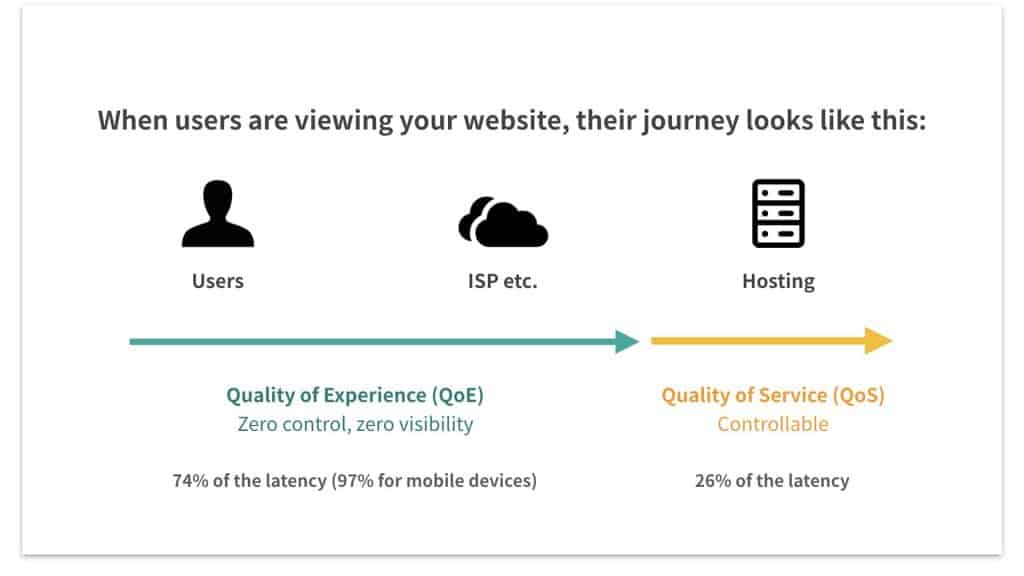For all business owners, it is vital to take on a proactive role that seeks to prevent downtime before it occurs. Relying on reactive solutions that are triggered only after a disaster occurs can leave your company needlessly vulnerable to negative end-user experiences.
This is especially true for the SaaS applications that consumers and businesses rely on for everything from banking to record keeping. When these applications go down or perform inadequately, revenue and reputation are at stake.
Let’s take a look at why SaaS applications sometimes experience these issues and explore some solutions.
Quality of experience concerns
Today’s consumers are technically savvy, but they don’t understand everything that goes into keeping a website or SaaS running smoothly and reliably. They expect to receive services or information when they try to access them.
When it comes to most websites including SaaS applications, the rule of thumb is that only 26% of service latency is under our control – the selection of a reliable host. We know that well-regarded web hosts are generally better prepared to handle unpredictable bursts of traffic, prevent security breaches, and maintain a consistent online presence. This reliability extends to SaaS applications accessed through portable devices, which are becoming more commonplace by the day.

What about the other 74%? Until recently, there seemed to be little the business owner could control about how service outages impact ISPs and end-users. CDNs, or content delivery networks, have changed the SaaS latency landscape.
CDN technology works by distributing services spatially to foster reliability and performance across web-reliant services. CDN can cache your website so that SaaS users are accessing cached data rather than requesting resources from the origin server. Instead, the site locates the nearest edge server (CDN) and requests resources from there. The result vastly improves the performance for “quality of experience” part.
Why is my SaaS still slow after I installed CDN?
Ideally, SaaS that utilizes the benefits of a CDN will perform better, but in reality, there are more factors that can impact the performance. Here are some of the common factors:
- DNS Server Quality – Cheaper DNS services, in particular, are often plagued by reliability issues. Research high-quality DNS options like Cloudflare or NS1.
- Hosting Issues – Ensure your hosting plan includes sufficient bandwidth, professional-grade equipment, and that the host itself prioritizes data security and overall reliability. Sometimes, you get what you pay for, and web hosting is one of those times.
- Website Optimization – Be sure your team is optimizing the code. This is an ongoing process. As your application evolves and technology changes, optimization needs may need to be fine-tuned.
Despite these factors, utilizing CDN technology is still a step in the right direction toward improving SaaS performance. The key is to acknowledge the limitations of CDN.
There is no perfect CDN
CDNs are not universally effective. For example, some CDNs have geographic limitations. Several well-regarded CDNs do not function in China. You might gravitate toward a big name like Cloudflare, but if you or your clients are located in China, performance may suffer there. Global CDNs seem like an obvious choice, but it can be a risk given that performance issues can affect users worldwide.
It is crucial, then, to not rely on a sole CDN provider. It is simply impossible to ensure a consistent end-user experience to all users around the world since any CDN is prone to at least the occasional technical issue.
-1024x576.png)
Placing all your trust in one CDN is a risky proposition. All technology is prone to issues that can impact performance. This is true of highly sophisticated, space-age nanotech down to the sensors that determine the crispiness of your morning toast.
Even the highest-rated CDNs that utilize the latest tech can fail. We need only consider the aftermath of the Cloudflare incidents, which took down e-commerce giant Amazon for several hours, to reach this conclusion.
So, are there any other ways we can improve the performance?
A true one-size-fits-all CDN: Multi CDN
Multi CDN harnesses the best of what a CDN can do and transforms it into a system that improves latency, uptimes, and cost-efficiency on a global scale. As its name implies, Multi CDN uses more than one CDN, distributing content from sources that best solve an end user’s geographical or network limitations.
Though it may sound complicated, the basic premise of a Multi CDN network is straightforward. Essentially, when an end-user launches a website, SaaS, or other web-based content, the best available CDN, based on various factors, is selected.
The benefits are remarkable. In the event of network interruption, traffic is automatically rerouted through another provider. The result is 100% service uptime, guaranteed. Unlike a single provider CDN, a Multi CDN can access a long list of CDN locations. Data requests are disbursed among many CDNs, relieving the load on your primary server.

In addition to serving as a solution to downtime created by a single CDN, Multi CDN helps improve redundancy. If one CDN goes offline, alternative providers are utilized, ending in imperceptible rerouting that keeps SaaS apps working for the end-user. Done well, this service can:
- Deliver stability and consistent uptime because you aren’t relying on a single network. Delivering content through multiple providers improves latency and uptimes. Reduce the adverse effects of vendor lock-in thanks to the multi-vendor approach. You can use vendors that facilitate Multi CDN versus vendors who rely on exclusivity.
- Provide multiple delivery contingencies. All providers have at least occasional downtime. Multi CDN finds the best network at any given moment.
- Promote balance among all facets of their company’s web presence. No matter how many applications, videos, website pages or other content you need to share, Multi CDN allows you to deliver consistent, fast streaming and page loading.
- Provide a better Quality of Experience for the end-user thanks to fewer outages and less service degradation. Client retention depends on providing a trustworthy, reliable service.
Key takeaways
There are several highly significant reasons for website administrators, and app developers to consider the advantages of Multi CDN technology.
In essence, wise administrators know not to put all their eggs in one basket. CDNs, like all technology, are prone to outages and performance issues. CDN providers perform differently in various geographies, sometimes not working at all in a given location. Reliability is inconsistent among CDN providers, and even well-regarded CDNs can experience downtime. CDN providers offer varying benefits.
Why not enjoy the best of multiple CDNs selected to best match your specific needs? Multi CDN technology allows users to do just that. Call it safety in numbers or getting ahead of the game. We call it a solution that works.



